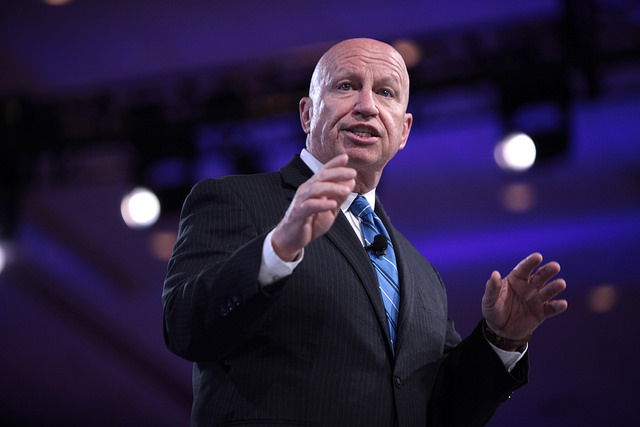American News
GOP tax plan may offer little aid for many in middle class

“We are focused on increasing paychecks in a major way,” said Rep. Kevin Brady, the Republican chairman of the House Ways and Means Committee. (Photo by Gage Skidmore/Flickr, CC BY-SA 2.0)
WASHINGTON — House Republicans have stressed that the tax plan they unveiled Thursday is tailored to benefit America’s middle class. Just how much it would remains uncertain based on the details that have been provided so far.
What is clear is that many of the benefits for the middle class could dwindle over time, even while companies and wealthy individuals could enjoy lasting tax advantages.
The plan promises tax savings next year of $1,182 for a typical household of four with gross income of $59,000, leaving their tax bill at $400.
“We are focused on increasing paychecks in a major way,” said Rep. Kevin Brady, the Republican chairman of the House Ways and Means Committee.
But the proposal’s conflicting provisions and phase-outs of certain benefits suggest that taxes could rise for some middle class earners over time. And for many, the income gains being touted by President Donald Trump are unlikely to materialize.
Some of these complications arise because under the budget instructions, the planned tax cuts can’t increase the national debt by more than $1.5 trillion over the next decade. Anything above $1.5 trillion would force Republicans to amend their plan to generate more revenue — a change that would likely prove difficult.
Trump has frequently said that this would be the biggest tax cut in U.S. history. But outside analyses show that that’s not the case.
The tax plan’s primary beneficiaries would be wealthier Americans, who would enjoy lower tax rates despite the elimination of some breaks, a repeal of the so-called alternative minimum tax and the termination of the estate tax.
“With the details they’ve presented to us so far, it looks like the tax cut benefits the wealthy and major corporations,” said Martin Sullivan, chief economist at Tax Analysts and a former staff economist at the Treasury Department. “In fact, if you have a large family, given the facts that we have now, that you would pay more in taxes.”
Here’s why:
A married couple making less than $90,000 would be taxed at a 12 per cent rate, instead of the current 15 per cent. The size of their standard deduction would nearly double to $24,000.
But that same couple would lose personal exemptions — deductions that largely benefit families with multiple children. The child tax credit would rise to $1,600 from $1,000 — short of the $2,000 that Sullivan said would be needed to make many families whole.
The tax plan would also repeal the deduction of substantial medical costs, including what families might spend on nursing home care. Nor could people with student loans deduct the interest paid on the debt anymore.
And the plan would cap the deduction of state and local taxes. It also would use a less generous measure of inflation, so that more middle class taxpayers would creep into a higher bracket over several years.
All told, nearly 70 per cent of the tax cuts would go to businesses over 10 years, according to an analysis by the Committee for a Responsible Federal Budget. The rest of the tax cuts appear to favour the wealthy.
Gary Cohn, the president’s top economic adviser, said Thursday at the Economic Club of Washington that the objective was to help the middle class. But he declined to say whether the wealthy would benefit.
“The hard part about taxes is everyone has got their own unique set of circumstances,” Cohn said.
The plan is already showing some splintering along ideological lines.
The conservative Tax Foundation’s analysis of how different families would fare under the plan suggested that the largest cuts as a percentage of taxes paid would go next year to sample couples earning between $48,000 and $85,000. Even a married couple with two children earning $165,000 would receive a reduction.
But liberal groups stressed the analysis of nonpartisan groups that the benefits would flow largely flow to major companies and the top 1 per cent of earners over time as tax breaks such as a new family credit would expire after five years.
“Tax cuts for the well-off are forever,” said Gene Sperling, a former top economic aide in the Obama and Clinton presidencies. “Tax cuts for the middle class are a small, a maybe and some-time thing that can be cut off in their plan.”
The overarching promise made to the middle class by Trump and congressional Republicans is that lower taxes would fuel faster economic growth, which, in turn, would cause incomes to rise. Kevin Hassett, chair of Trump’s White House Council of Economic Advisers, estimates that lowering the corporate tax rate to 20 per cent from 35 per cent would lead to an average income gain of $4,000 a year.
But most mainstream economists have disputed that claim. Kent Smetters, faculty director of the Penn Wharton Budget Model, estimates that the income growth after a decade would range between $500 to $1,500.
Some tax experts say the tax overhaul might also hurt those who aspire to be middle class. The bottom half of taxpayers now pay no net income tax, according to Treasury Department figures. Many receive refunds via the Earned Income Tax Credit. The plan unveiled Thursday would require eligible taxpayers to provide their Social Security Number to receive this benefit, thereby creating a possible delay in receiving a refund as the IRS enforces this provision.
David Kamin, a former Obama White House official who now teaches law at New York University, said the plan seems to have “no significant help of any kind for about the bottom 35 per cent of income earners.”
He added that the proposal could also “run up deficits significantly that would eventually have to be paid for and could threaten programs that do help low and middle income Americans whether that be health care coverage, Social Security, or investments like in infrastructure.”





















